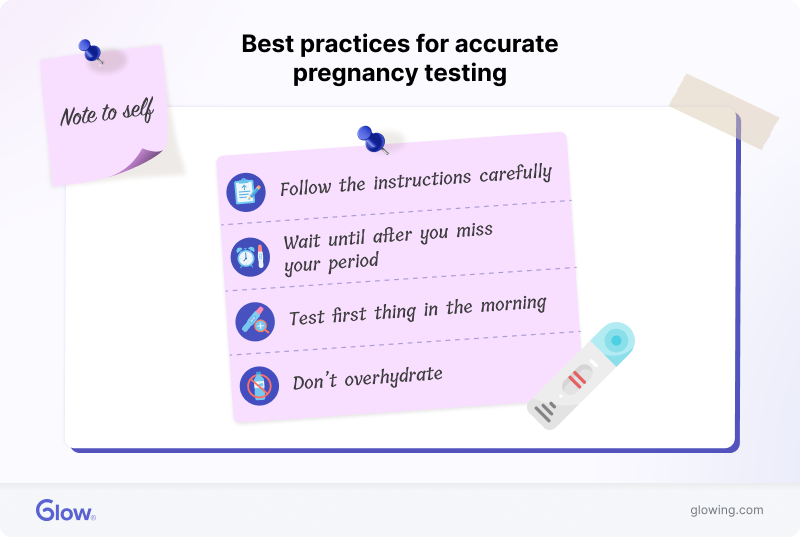What Does a Faint Line on a Pregnancy Test Mean?
Whether you’re trying for a baby or not, waiting for those small lines to appear on your pregnancy test can be anxiety-inducing. If, when they finally showed up, they were a lot fainter than you expected, it’s understandable if that left you searching for answers.

- What does a faint result on a pregnancy test look like?
- Does a faint line on a pregnancy test mean you’re pregnant?
- What should you do after seeing a faint line on your pregnancy test?
- What if you get your period after seeing a faint line on a pregnancy test?
- Best practices for accurate pregnancy testing
- Final thoughts
Most of the time, a faint line on a pregnancy test indicates that you’re pregnant, but that isn’t always true. Read on to learn how to decipher this frustratingly ambiguous result—and what you should do next.
What does a faint result on a pregnancy test look like?
Usually, a faint line on a pregnancy test looks exactly like what you’d expect: a light-colored, barely visible mark in the “results” window. It will appear next to the “control” line (which tells you that the test is working properly).
However, different brands of pregnancy tests display their results in slightly different ways. Depending on the type of test you have, a faint result can also look like:
- A light plus sign
- A smudge or a barely perceptible change in shading
This is assuming you took a “regular” pregnancy test strip instead of a digital one. Digital tests usually display clear words like “pregnant” or “not pregnant” instead of lines or plus signs.
Does a faint line on a pregnancy test mean you’re pregnant?
Even though it might be faint, a line usually means you’re pregnant. However, that isn’t a certainty; you’ll need to test again in a few days or weeks to confirm your pregnancy. 1
What can cause a pregnancy test result to be faint?
If the line on your test was unusually light or faint, the most likely explanation is that you tested for pregnancy too early (i.e., too soon after conceiving). 1
To understand why this is, you need to know a bit about how pregnancy tests work. They detect a hormone called “human chorionic gonadotropin” (hCG), which your body produces after a fertilized egg implants in your uterus. 2
Implantation occurs around 6–10 days after conception. During the first few days of pregnancy, hCG is only present in small amounts. After around 10 days—a few days before your period would otherwise have been due—there may be enough of it in your system for you to test positive on a pregnancy test, but the amount may be borderline, leading to a weaker result.
In general, it takes about two weeks from the date of conception until you can realistically expect to see a positive test. That’s why the stretch before testing is known (somewhat infamously) as the two-week wait.
The upshot is that if you wait just a few days longer until the date of your next expected period, your hormones will have had enough time to surge, and you’ll probably get a clearer result.
Other common reasons that pregnancy tests return weak results
There are a few other reasons why the line on your pregnancy test might be faint (despite you being pregnant). The most likely ones include:
- You drank too much water: How concentrated your urine is affects how much hCG is present in it. Testing later in the day, especially after drinking a lot of liquid, can dilute the hormone enough to confuse the test.
- You used a less sensitive test: Not all pregnancy tests are equally sensitive. Some require higher levels of hCG to trigger an unambiguously positive result. If that’s the case, you might be able to get a clearer line by trying again with a different brand.
- You used an expired or improperly stored test: Pregnancy tests that are expired or have been exposed to heat, moisture, or direct sunlight may not function as intended, which can lead to unclear or inaccurate results.
To reiterate, in each case, the presence of the faint line probably still indicates that you’re pregnant. The sign just isn’t as clear as you might want.
Can a faint line ever mean you’re not pregnant?
It’s rare to see a faint line on a test and turn out to not have been pregnant. A faint positive result is still a positive result, and pregnancy tests are between 97% and 99% accurate. 3
However, a 1%–3% chance of error does mean that mistakes can occur, especially outside of controlled and sterilized laboratories. You may get a false positive pregnancy test in these (uncommon) situations: 4
- Recent miscarriage or abortion: If you were recently pregnant but suffered a miscarriage or had an abortion, your hCG levels may still be high enough to be detectable on a pregnancy test, leading to a positive result.
- Going through menopause: Menopause can temporarily boost your hCG levels. If you’re going through menopause and you take a pregnancy test, you might see a positive result, although this is rare. 5
- Undergoing fertility treatments: Certain fertility treatments and medications containing hCG can elevate your hormone levels. Very rarely, this can result in a false positive.
- Rare medical conditions: Some medical conditions, such as ovarian cysts and certain types of cancer, can also cause elevated hCG levels, sometimes resulting in false positives. 67
Evaporation lines
What’s more, sometimes, a faint line on a pregnancy test can actually be an “evaporation line” instead of a positive result. Evaporation lines occasionally appear on home pregnancy tests as your urine dries. You can tell these from genuine positive results by evaluating their:
- Color: A faint positive line will have the same color as the control line. In contrast, an evaporation line will typically be colorless, gray, or appear as a shadow.
- Timing: Evaporation lines form when a test sits too long after the reading window. Faint positive results, however, appear within the test’s designated timeframe, while the strip is still damp.
- Shape: Faint positive lines are consistent in thickness and run the full length of the result window. Evaporation lines may appear irregular, faintly streaked, or inconsistent in shape.
The upshot of all of this is that it can be hard to figure out what’s going on when you see a faint line on your pregnancy test. Fortunately, you don’t actually have to—regardless of the cause, what you should do remains the same.
What should you do after seeing a faint line on your pregnancy test?
Because a faint line on your test strongly suggests you’re pregnant (but doesn’t completely confirm it), you should follow it up by taking the following steps:
Repeat the test
Your first step should be to retest yourself. You can do this immediately if you’d like, but it’s possible you’ll get another unclear result; to get a better one, you can wait 2–3 days.
By then, your hCG levels should have risen enough to produce a clearer result. If they still don’t, proceed to the next step.
Track your cycle and symptoms
If you haven’t already done this, take a look at your ovulation cycle and think about how likely it is that you conceived. If you think there’s a chance, consider whether you have any early pregnancy symptoms, such as:
- Nausea (morning sickness)
- Fatigue
- Breast pain and tenderness
Those symptoms don’t always manifest this early, but it’s possible for them to appear just a week or two after conception.
While their presence doesn’t guarantee that you’re pregnant (there are lots of reasons you could be feeling queasy), when they’re combined with a faint positive result on a pregnancy test, they’re pretty strong clues.
Speak with your doctor
If you’re still not sure whether you’re pregnant, you can see your doctor to find out for sure. They can perform a blood test to measure your hCG levels more accurately.
If the lines on your pregnancy tests remain unusually faint, this is worth doing even if you’re pretty sure that you’re pregnant. Your doctor can also use the blood test to make sure the inconclusive result isn’t being caused by a condition that requires treatment, such as an ectopic pregnancy (implantation outside the uterus).
What if you get your period after seeing a faint line on a pregnancy test?
If you get your period a few days or weeks after seeing a faint line, it may mean that you’re not pregnant. It’s possible the test was wrong, or it’s possible that you were briefly pregnant, but no longer are.
It’s also possible that you just have first trimester bleeding. About a quarter of women experience this. 8 If you’re one of them, then any blood you see isn’t from your period at all; it’s just a pregnancy symptom.
Chemical pregnancies
If it turns out you really have your period, one of the most likely explanations is that you had a chemical pregnancy, a type of miscarriage where the egg was fertilized but didn’t fully implant.
While this can be upsetting if you and your partner were trying for a baby, rest assured that having a chemical pregnancy doesn’t affect your future chances of getting pregnant.
Make sure to rule out spotting (implantation bleeding)
Getting pregnant often results in light spotting, known as implantation bleeding. This happens when the fertilized egg implants in your uterus. Spotting shouldn’t be enough to completely soak through a pad; see your doctor if this bleeding is unusually heavy.
Best practices for accurate pregnancy testing
To save yourself the frustration of fretting over inconclusive tests, here are a few best practices to ensure that you get the most accurate results possible:
- Follow the instructions carefully: Pay close attention to details such as how to collect your sample and the timeframe for reading the results. Additionally, make sure you check the expiration date before using a test.
- Wait until after you miss your period: As mentioned, your hCG levels are initially quite low when you only just got pregnant. Waiting until you’re pretty sure you missed your period will always lead to more accurate results.
- Test first thing in the morning: Your urine is typically more concentrated just after you wake up, which means the test will give more accurate results.
- Don’t overhydrate: Again, drinking large amounts of water dilutes your urine, making it harder for the test to detect hCG. Staying hydrated is great, but don’t overdo it if you’re planning on taking a pregnancy test.
- Consider test sensitivity: If you plan to test before your next period is due, choose a test labeled “early detection.” These are designed to identify lower levels of hCG and may provide clearer results in the early stages of pregnancy. However, even with a sensitive test, waiting until after your missed period is more reliable.
Avoid bogus DIY pregnancy tests
You may have heard that you can test for pregnancy with salt, toothpaste, sugar, or even bleach.
While it might be tempting to save a few bucks and make your own test, know that there’s no evidence to support these homemade pregnancy tests. You’re best off sticking with pregnancy tests that are actually backed by science.

Final thoughts
Whether you’re an eager parent-to-be or you’re praying to remain childfree, home pregnancy tests can cause a lot of stress. Follow the best testing practices and seek medical guidance if you need it. Above all, don’t panic, and be patient—you’ll get a clear enough result in time.
Article Sources
- Geburtshilfe Frauenheilkunde. "Strips of Hope: Accuracy of Home Pregnancy Tests and New Developments" Retrieved April 15, 2025.
- ScienceDirect. "Human Chorionic Gonadotropin" Retrieved April 15, 2025.
- MedlinePlus. "Pregnancy Test" Retrieved April 15, 2025.
- Healthline. "7 Possible Causes of a False Pregnancy Test" Retrieved April 15, 2025.
- CCRM Fertility. "8 Possible Causes for a False-Positive Pregnancy Test" Retrieved April 15, 2025.
- American Journal of Case Reports. "A Case of a False-Positive Urine Pregnancy Test and Delayed Diagnosis of Obstructive Pyelonephritis" Retrieved April 15, 2025.
- Obstetrics & Gynecology. "Reducing False-Positive Pregnancy Test Results in Patients With Cancer" Retrieved April 15, 2025.
- American Family Physician. "First Trimester Bleeding: Evaluation and Management" Retrieved April 15, 2025.







